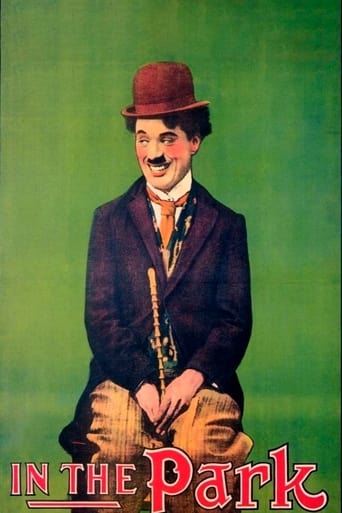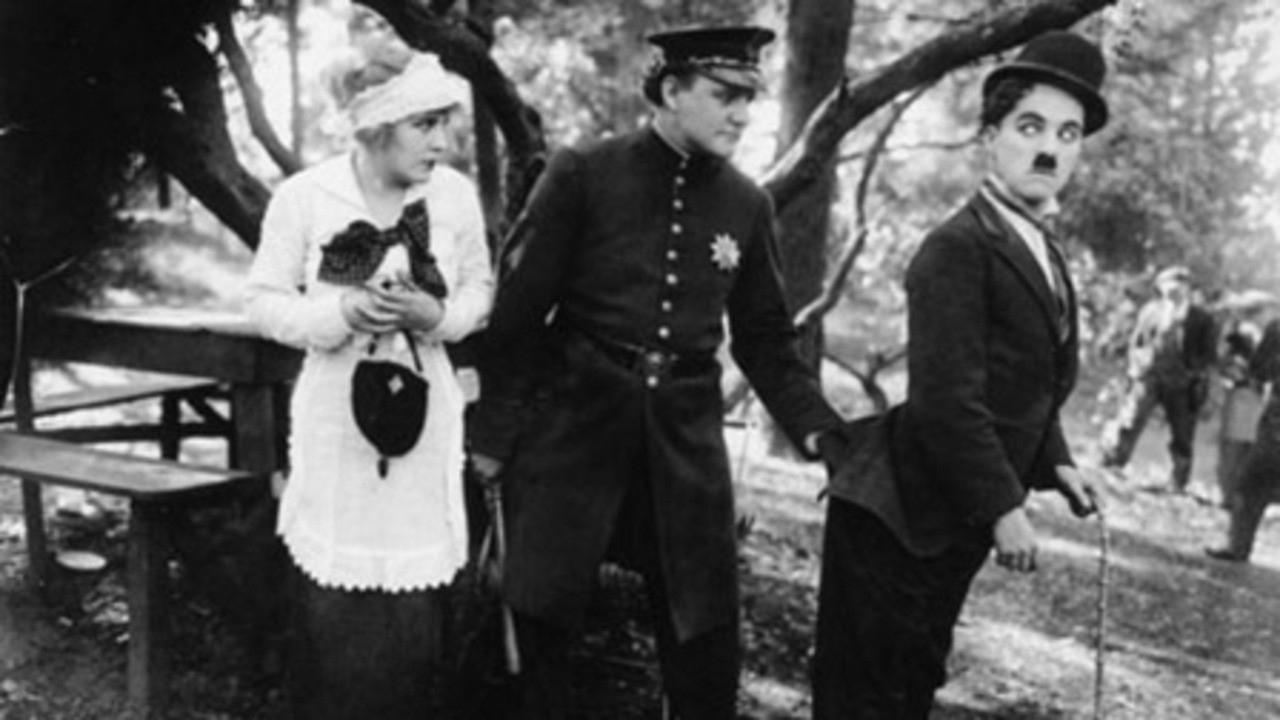TheLittleSongbird
Am a big fan of Charlie Chaplin, have been for over a decade now. Many films and shorts of his are very good to masterpiece, and like many others consider him a comedy genius and one of film's most important and influential directors. From his Essanay period after leaving Keystone, 'In the Park' is not one of his very best or even among the best of this particular period. It shows a noticeable step up in quality though from his Keystone period, where he was still evolving and in the infancy of his long career, from 1914, The Essanay period is something of Chaplin's adolescence period where his style had been found and starting to settle. Something that can be seen in the more than worthwhile 'In the Park'. 'In the Park' is not one of his all-time funniest or most memorable, other efforts also have more pathos and a balance of that and the comedy. The story is still a little flimsy, there are times where it struggles to sustain the short length, and could have had more variety and less more of the same repeition.On the other hand, 'In the Park' looks pretty good, not incredible but it was obvious that Chaplin was taking more time with his work (even when deadlines were still tight) and not churning out as many countless shorts in the same year of very variable success like he did with Keystone. Appreciate the importance of his Keystone period and there is some good stuff he did there, but the more mature and careful quality seen here and later on is obvious.While not one of his funniest or original, 'In the Park' is still very entertaining with some clever, entertaining and well-timed slapstick. It moves quickly and there is no dullness in sight. Chaplin directs more than competently, if not quite cinematic genius standard yet. He also, as usual, gives an amusing and expressive performance and at clear ease with the physicality of the role. The supporting cast acquit themselves well, with charming Edna Purviance and the amusing hot dog vendor.Summing up, worth a look though Chaplin did better. 7/10 Bethany Cox
James Hitchcock
During my childhood in the sixties and seventies, I was surprisingly familiar with the silent comedies made by the likes of Charlie Chaplin, Ben Turpin, Harold Lloyd, Buster Keaton and the Keystone Kops, as these films were still regularly shown on television at this period. Although I and some of my friends used to enjoy them, I don't think that they were mainly aimed at children. The target audience were probably older people of my grandparents' generation who would have had nostalgic memories of such films from their own youth in the 1910s and 1920s, and it is probably the passing of that generation which has been responsible for their virtual disappearance from terrestrial television. Even on specialist movie channels they only turn up rarely, although the internet now offers new possibilities for watching them."In the Park" is an early Chaplin short from 1915, which not only stars the great man but was also written and directed by him. I don't think that Charlie is supposed to be a tramp in this film but he wears the costume- bowler hat, walking stick, baggy trousers and toothbrush moustache- which were associated with his "Little Tramp" character. As the title suggests, the action all takes place in a park. There isn't really a good deal of plot, just a series of visual gags revolving around Charlie, a remarkably incompetent pickpocket, a hot dog vendor, a policeman, a courting couple and a nursemaid (played by Edna Purviance, one of the silver screen's first sex symbols).I call them "gags", although actually there is nothing particularly funny about any of them. Indeed, what struck me most forcibly about the film is just how unfunny and mean-spirited the attempts at humour are. Chaplin obviously assumed that the best way to get laughs was to kick someone, throw a brick at them or to push them into a pond. When he isn't committing criminal assault on his victims he is trying to steal their property. Why my grandparents' generation found this sort of thing funny is a mystery; I can only assume that in 1915 the cinema was such a novelty that people would flock to whatever was on offer, regardless of quality. Chaplin could do much better than this.
wmorrow59
At one point in the 1930s, a period when Charles Chaplin would spend years making a single feature film, he remarked to a friend that in his early days all he needed was a cop, a park bench, and a pretty girl, and -- Presto! -- he and his crew could crank out a new comedy in a day or two. And indeed, he made so many films that way in 1914 (his year of apprenticeship with Keystone) they're practically interchangeable. Unfortunately, however, he had no control over the handling of these films after he left the company, and most were re-edited, retitled, and mixed up in dizzying ways by distributors out to make a buck. Thus, there are two Chaplin movies known as "In the Park." One is a reissue of a 1914 Keystone comedy originally titled Caught in the Rain, and the other is an Essanay release of the following year. Very little of the Keystone film actually takes place in a park: it's a marital farce involving sleepwalking and drunken bedroom-hopping, set mostly in a hotel. The "real" In the Park is appropriately named, for it has no interior scenes at all.In his films of 1915 Chaplin begins to demonstrate a little more finesse, and his Tramp character is more sympathetic. Even in such a brief and simple film as the Essanay version of In the Park we find a coherent through-line (albeit no plot as such), touches of whimsy, and some cleanly executed physical comedy. The tempo is fairly relaxed and slapstick violence is kept to a minimum, at least compared to the earlier films. While the Tramp is of course the central character, Chaplin also deftly choreographs the movements of his supporting players: a nursemaid, a thief, courting couples, a cop, etc. Charlie has plenty of colorful characters to react to, flirt with, or fight, as the occasion demands.I love Charlie's first scene with Edna the nursemaid, the way he leers at her, plays with his hat, and casually (Harpo-like) plops his leg into her lap. Along with the Keystone style brick-hurling and head-bopping we have Charlie playing with a string of sausages just for the fun of it, while portly Bud Jamison skips about the park like Baby Huey. I like the fact that Edna is given a brief comic moment of her own: she is first seen sitting on a bench, reading a book mysteriously titled "Why They Married." (Well hey, why not?) The other players still wear heavy makeup and emote vigorously, but Chaplin himself is more nuanced and self-assured as a performer, and less frenzied than in some of the earlier films. In the Park is no masterwork, but it does serve to showcase Chaplin's development from diamond-in-the-rough to the supreme comic artist and filmmaker he would soon become.
Michael DeZubiria
***SPOILERS*** ***SPOILERS*** In The Park starts off with a scene that is very similar to one of Chaplin's other short films, By The Sea, where Charlie comes across a woman who is involved with another man. In this scene, Charlie approaches her and flirts with her while her oafish husband is temporarily away, and when he comes back, an argument ensues that ends with Charlie getting knocked backwards over a park bench. After this, however, the remainder of the film takes place in the apartment building where all three people live, even right across the hall from each other (seems strange that they don't know each other).The thing that really takes away from this film is that there is so much that happens during the film that does not make much sense and is not explained, even in the limited way that is available in a silent film. For example, after having encountered the couple in the beach and after they have stormed off, Charlie staggers back home as though he is drunk, but we never see him drink, other than in an amusing attempt to drink from a water fountain in the park at the beginning of the film. When he gets to the hallway (which can be recognized as the exact same hallway as was seen in another of Chaplin's short comedies, called The Rounders), he accidentally wanders into the wrong room, thinking it's his (maybe it's because that was his room in The Rounders?), and continues with his unexplained drunken behavior. He picks up a bottle, pours something out of it onto his hat, combs his hat briefly, and then drinks from the bottle. Clearly, this is something that is not uncommon to see Chaplin do in one of his films, but we have no idea why he is acting like that.Charlie eventually finds his way back to his own room, undresses at length, and crawls into bed, even though it could not have been more than half an hour since he was in the park, at which point it was broad daylight. As he is about to go to sleep, the other man's wife sleepwalks into his bed, and the better segment of the film follows. It is hilarious to watch Charlie trying to get this man's wife back into her own room without her husband finding out, and the scenes in which this happens are much better than the film as a whole, even though this also leads to more confusion as to what exactly is happening. The police wind up getting involved, and the film seems to end right in the middle of the final conflict.
While it's obvious that In The Park does not compare to the high quality of the majority of Chaplin's early silent comedies, the style and the skill are unmistakable. Even though this movie has more than it's share of unfortunate shortcomings, Chaplin's presence alone makes it a very entertaining film.


 AD
AD



